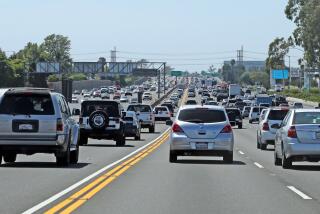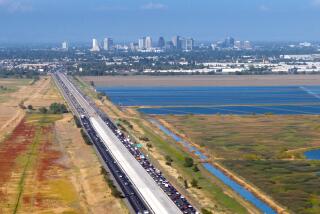Transportation Crossroads: National Priorities at Issue
- Share via
The federal government’s comprehensive transportation law, which coordinates funding for everything from highway building to mass transit, expires at the end of September. Legislation to extend, alter or scuttle it is now under consideration. To understand why this is so important to California and the nation, consider the following:
The Intermodal Surface Transportation Efficiency Act (ISTEA) is quite the bureaucratic mouthful. It is also one of Washington’s biggest programs and arguably one of its more successful. Since 1991, it has allocated billions of transportation dollars for everything from the interstate highway system to freight movement programs. It also emphasized, for the first time, the relationship between different modes of transportation, and it focused on how to make them work in concert. Examples include the funding of improved rail and truck access to major commercial harbors.
It moved the nation beyond an overwhelming emphasis on the interstate highways, a system now largely complete. Moreover, this legislation gave state and local officials significant flexibility to spend funds as they saw fit. ISTEA also including funding for alternative modes of transportation and encouraged improvements in congestion management and air quality. With the act about to expire, congressional committees are considering a host of funding alternatives. Some ill-conceived proposals would largely eliminate the federal role and shift practically all power to the states. Others would attempt to make sure that every state got back an equal percentage of the federal gas tax it had paid out. That sounds nice but fails to recognize the role played by California as one of the heavy lifters in moving international goods into the rest of the nation and in moving U.S. exports overseas.
Of the proposals, two stand out as meritorious. One, authored by Sen. Daniel Patrick Moynihan (D-N.Y.), has more than 35 co-sponsors, including California Sens. Dianne Feinstein and Barbara Boxer. The proposed ISTEA Reauthorization Act of 1997 would preserve and bolster the forward-thinking approach of the original bill as well as increase funding for highways.
The other good alternative comes from the Clinton administration. It’s the proposed $175-billion National Economic Crossroads Transportation Efficiency Act, or NEXTEA. Under it, California and other key states would get a bigger share of a larger pot of money. It also puts the funding in a proper context--as one of the mechanisms that would help the nation compete in terms of international trade.
The Clinton proposal contains some questionable items that deserve further thought, such as another huge subsidy for Amtrak and tolls on national highways. But both the Moynihan bill and the Clinton alternative present useful solutions. Whatever emerges from the Congress ought to embrace the same priorities: a balanced improvement in transportation infrastructure that builds on the success of the past six years. The nation should move past an outmoded emphasis on highways alone.
More to Read
Sign up for Essential California
The most important California stories and recommendations in your inbox every morning.
You may occasionally receive promotional content from the Los Angeles Times.










